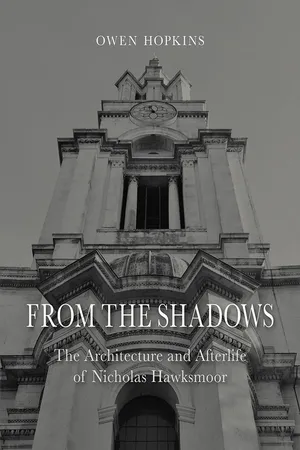![]()
REFERENCES
INTRODUCTION: THE MAN AND THE MYTH
1 Kerry Downes, Hawksmoor (London, 1959), p. 6. Kerry Downes suggests that the slab, which was cut in 1736 by Andrews Jelfe, may have been underground at one time.
2 Ibid., p. 6.
3 For this and following references, see Iain Sinclair, London Orbital (London, 2003), pp. 158–61.
4 Temple Bar is the spot on Fleet Street where the City of London ends and Westminster begins. A gateway designed by Christopher Wren acted as the symbolic and regulatory threshold between the two jurisdictions until the late 1870s when it was removed as an impediment to traffic. It was re-erected and stood for over 100 years at Theobalds Park, Hertfordshire, where Sinclair saw it, before it returned to London to form part of the regenerated Paternoster Square, north of St Paul’s Cathedral, in 2004.
5 According to Downes, Hawksmoor’s will was made in January 1730. See Downes, Hawksmoor, p. 6, n. 13.
6 Peter Ackroyd, Hawksmoor (London, 1985), p. 5.
7 The exhibition was entitled Nicholas Hawksmoor: Methodical Imaginings, curated by Mohsen Mostafavi, Dean of Harvard University Graduate School of Design. After the Biennale it was shown at Somerset House, London (15 May–1 September 2013). A book deriving from the exhibition, Nicholas Hawksmoor: Seven Churches for London, was published by Lars Müller Publishers, Zurich, in Spring 2014.
8 Bunkers, Brutalism and Bloodymindedness: Concrete Poetry with Jonathan Meades, episode One, first broadcast on BBC Four, 9 pm, 16 February 2014.
1 EMERGENCE
1 In Hawksmoor’s entry in the Oxford Dictionary of National Biography (Oxford, 2004), Kerry Downes notes that the baptismal records for this period are incomplete; the assumption of 1662 is based on a calculation Hawksmoor made on the back of a drawing from 1707 which is now in the British Library; online edn, www.oxforddnb.com, accessed 6 July 2014. Some observers have favoured 1666 as the date of Hawksmoor’s birth for the occultist connotations of the number and perhaps also the momentousness of the year that saw the Great Fire of London.
2 In the ODNB entry on Hawksmoor, Downes suggests the local grammar school in Dunham as a possible place of Hawksmoor’s early schooling. The obituary appeared in Read’s Weekly Journal, no. 603 (27 March 1736) and notices also appeared in the Old Whig, no. 56(1 April 1736) and the Gentleman’s Magazine, VI (1736), p. 168. See Kerry Downes, Hawksmoor (London, 1959), p. 7, n. 15.
3 Mellish owned property near East Drayton, indicating that Hawksmoor almost certainly still resided there at this time. Hawksmoor’s connection with Gouge is suggested by George Vertue. See Downes, Hawksmoor, p. 1, where he quotes from George Vertue’s ‘Notebooks’, Walpole Society, XXII (1933–4), p. 51.
4 Lisa Jardine, On a Grander Scale: The Outstanding Career of Sir Christopher Wren (London, 2003), p. 328.
5 Ibid., p. 280.
6 Wren was also knighted in the same year and this, together with his resignation of his position as Savilian Professor of Astronomy at Oxford, marked the completion of his transition from scientist to architect. See Jardine, On a Grander Scale, pp. 283, 289.
7 Hooke also served as one of the City Surveyors while also largely taking care of the day-to-day running of Wren’s architectural office. See Jardine, On a Grander Scale, pp. 297–8.
8 Faith was the daughter of Sir Thomas Coghill of Bletchingdon. See Jardine, On a Grander Scale, p. 281.
9 Ibid., p. 283.
10 Downes, ‘Hawksmoor, Nicholas’, ODNB.
11 Anthony Geraghty, ‘Nicholas Hawksmoor and the Wren City Church Steeples’, The Georgian Group Journal, X(2000), p. 1; and also more generally, Anthony Geraghty, ‘Introducing Thomas Laine: Draughtsman to Sir Christopher Wren’, Architectural History, XLII (1999), pp. 240–45.
12 Geraghty, ‘Hawksmoor and the Wren City Church Steeples’, p. 2.
13 Gordon Higgott, ‘Wren and his Draughtsmen’, St Paul’s Cathedral Wren Office Drawings catalogue (2013), www.stpauls.co.uk, accessed 6 July 2014. Higgott cites Wren Society, XIV (Oxford, 1939), pp. 84–5; and Wren Society, XVI (Oxford, 1937), p. 67.
14 For a good overview of the history of the cathedral, see St Paul’s: The Cathedral Church of London, 604–2004, ed. Derek Keene, Arthur Burns and Andrew Saint (New Haven, CT, and London, 2004), particularly the following essays: Gordon Higgott, ‘The Fabric to 1670’, pp. 171–90; and James W. P. Campbell and Robert Bowles, ‘The Construction of the New Cathedral’, pp. 207–19.
15 Jardine, On a Grander Scale, pp. 286–7.
16 Lyd...
